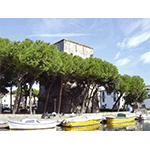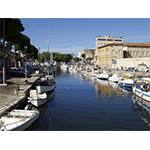Torre Matilde [Mathilde's Tower]
Viareggio was the natural sea mouth of the Republic of Lucca. The old port sited on a canal connected to the Burlamacca Canal was, at that time, a simple landing place in shallow water, which prevented large boats from docking, and was thus clearly outclassed by the nearby port of Livorno. Shortly before the mid 16th century, the Senate of the State of Lucca ordered the construction of a powerful military structure in defence of the port, today known as Torre di Matilde (its name comes from the erroneous attribution to countess Mathilde of Canossa).
The tower is sited along the Burlamacca Canal, the navigable emissary of Lake Massaciuccoli that ends in the sea. The old waterway takes its name from the Burlamacchi, a noble family of Lucca, perhaps because it crossed their lands. It was built following ancient routes probably tied to the ancient "Fossae Papirianae", built by the Romans to reclaim the coastal area.
In the first half of the 18th century, several rehabilitation works were carried out in the port of Viareggio. The techniques utilised to realise masonry on the open sea were noted by scholar Georg Christoph Martini in his Viaggio in Toscana [Tour of Tuscany]. After building the caissons with robust wooden boards, up to a height slightly more than sea level, and caulkers to render them watertight, the construction of walls began in summer with calm seas. Martini noted: «As the weight of the concrete gradually increases, the caisson sinks deeper into the water until it settles on the floor; then they connect it with boarding to the existing wall and cover the upper part with boarding to protect it from sudden storms, until the lime has set. When the caisson is ready, large rocks are set around it to protect it from the force of the sea. At times, instead of using rocks, serried palisades are planted».
Only in the early 19th century did Maria Luisa di Borbone order the restructuring of the port and, in 1828, entrusted architect Lorenzo Nottolini with drawing up an urban plan for Viareggio which was taking on the shape of a veritable little city.
Torre Matilde represents the symbol and fulcrum that Viareggio developed around. The tower was used as a prison from the 19th century until World War II. Restoration has also recovered its internal structure composed of three floors, a terrace and a space for a cistern. Today, the building hosts cultural events and temporary exhibitions of figurative arts.
****************************
Texts by Graziano Magrini
English translation by Victor Beard
Last update 24/gen/2008





